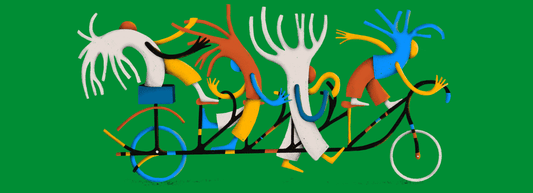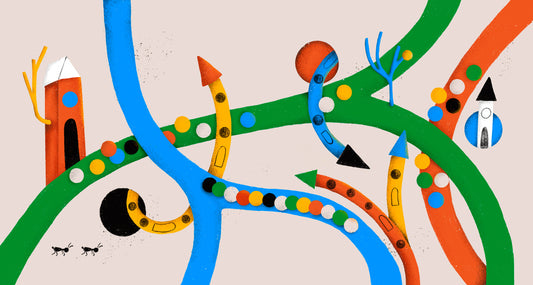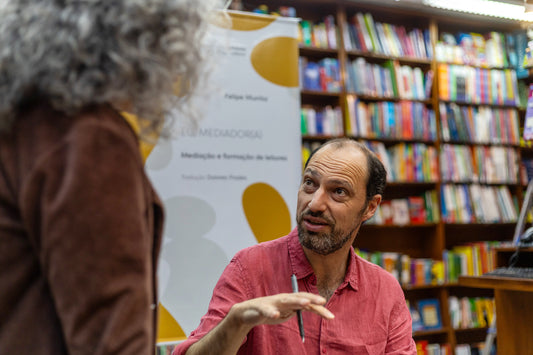Por Eduarda Uzêda
“Migrantes,refugiados, deslocados, bombardeios, violência, guerra, fome, medo, êxodo, campos, meninos, meninas, órfãos, barcos, resgates, afogados, fronteiras, apátridas,ilegais,desaparecidos,crise humanitária, pacto mundial sobre migração, direitos humanos... silêncio. Quantas fronteiras eles têm de cruzar para chegar em casa?”. O texto é do cineasta grego Theo Angelopoulos (1935- -2012) e está presente na contracapa do livro de arte Migrantes, da artista visual peruana Issa Watanabe.
A obra traz ilustrações sem palavras, mas que dizem tanto quanto as do diretor. Não só falam, como evocam, causam comoção e provocam reflexões. A publicação que narra a jornada de migração de um grupo de animais antropomorfizados (remetem a homens, mulheres, velhos e crianças que aparentam diferentes nacionalidades) têm grande força imagética.


Apresenta também um testemunho impactante de todo sofrimento daqueles que deixaram uma vida de angústias e incertezas para trás, em busca da esperança de dias melhores. Em tempos de crise de refugiados no Afeganistão, com a tomada do poder pelo grupo extremista islâmico Talibã, os registros de milhares de pessoas amontoadas no aeroporto e algumas penduradas no avião, para fugir de um destino trágico, chocam tal como o testemunho de Watanabe, que parece clamar por ações humanitárias.
Em Migrantes, os animais/humanos atravessam florestas escuras de árvores sem folhas, talvez metáfora dos regimes opressivos que destroem os frutos da vida e da criação. Quase no fim da jornada, flores descoloridas já aparecem e, depois, as cores retornam às folhas das árvores. Mas na contracapa voltam as florestas escuras, sinalizando um ciclo que deverá se repetir.
Edição primorosa
A edição brasileira, fruto da parceria do Selo Emília, Solisluna Editora e Livros da Raposa Vermelha, é primorosa. O livro de capa dura e com belas ilustrações, lançado recentemente no Brasil traz os animais antropomorfizados em cenas que também consternam o mundo: os fugitivos apinhados em um barco no oceano, enfrentando as correntezas e os temporais.
Quem não se lembra das tristes imagens dos africanos que chegaram em precárias embarcações às ilhas italianas de Lampedusa e Sicília?
Dos corpos–inclusive de crianças – boiando no mar? e das dezenas de migrantes que foram encontrados mortos em botes de borracha no Mediterrâneo, aparentemente sufocados após inalar combustível?
No livro de Watanabe, os migrantes, durante a travessia pela floresta, são acompanhados de perto pela morte, desenhada com um rosto de caveira e um manto florido. Até quando viajam pelo mar, a morte os vigia montada em um belo pássaro azul (um pelicano?). É esta morte pequenina que ampara um coelho, que não resiste e foi deixado para trás pelos outros bichos. Eles lamentam a perda, mas precisam prosseguir a viagem.

Fotojornalismo
Em entrevista para a edição portuguesa, a autora afirma que os primeiros desenhos de Migrantes foram desencadeados por um trabalho do fotojornalista sueco Magnus Wennman com crianças sírias, vítimas de guerra, e por uma história vivida pela autora em Maiorca, Espanha, com o acolhimento de um refugiado.
Watanabe queria contar às crianças e aos adolescentes,independentemente da cultura ou origem geográfica, o que é a migração forçada sem mascarar os fatos. A opção por desenhar animais e por ter feito um livro sem palavras acabou conquistando também os adultos.
Este é um Livro para ler várias vezes porque, a cada momento, um detalhe do traço da autora se torna mais emblemático. É uma obra para ler com crianças que irão perguntar muitas coisas, a exemplo de: por que a morte oferece uma maleta aos viajantes? Por que estão fugindo?Hora de refletir e elaborar respostas.
É uma publicação para se desfrutar ao lado do amado, relembrando a experiência de migração em terra estrangeira. Ou para se ler sozinho, e chorando em silêncio, porque as palavras não dão conta de tudo, e o sentido do termo humanidade parece que se perdeu. E como lembra o poeta peruano Javier Heraud, citado em outra edição do livro da autora, “cada um é feito de um pedaço de morte e de caminho...”.
É uma edição para presentear os outros e a si mesmo.
(Texto publicado no Jornal A Tarde em 23/8/2021.)








1 comentário
Sejamos fortes para saber fazer a diferença…